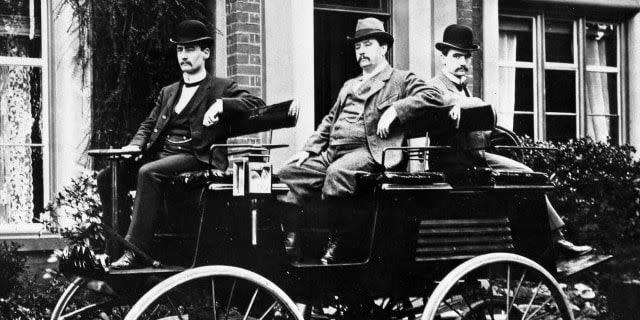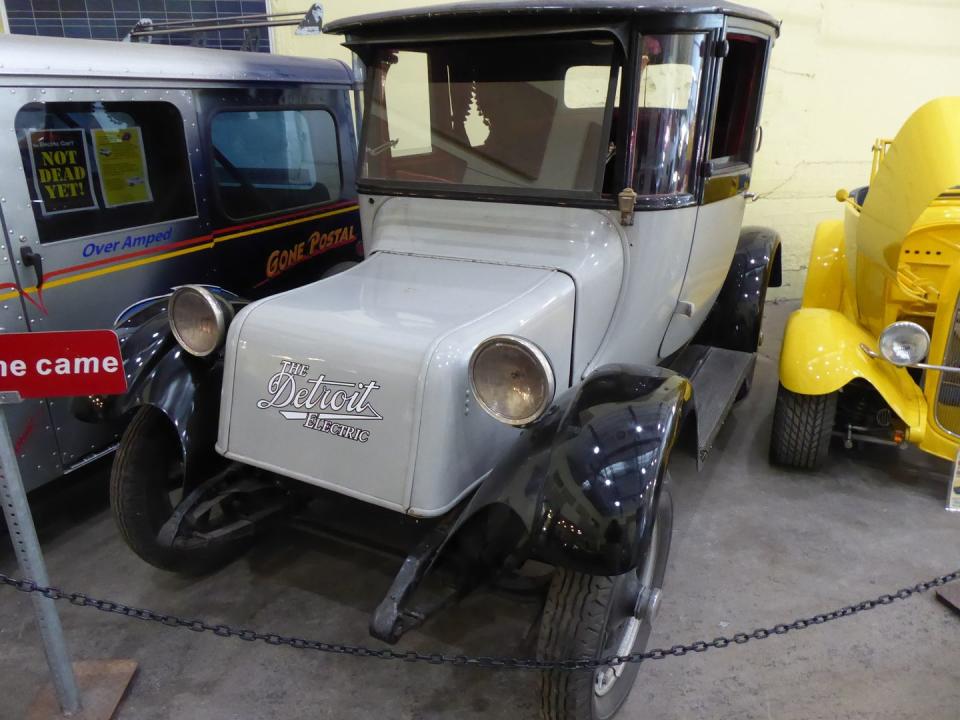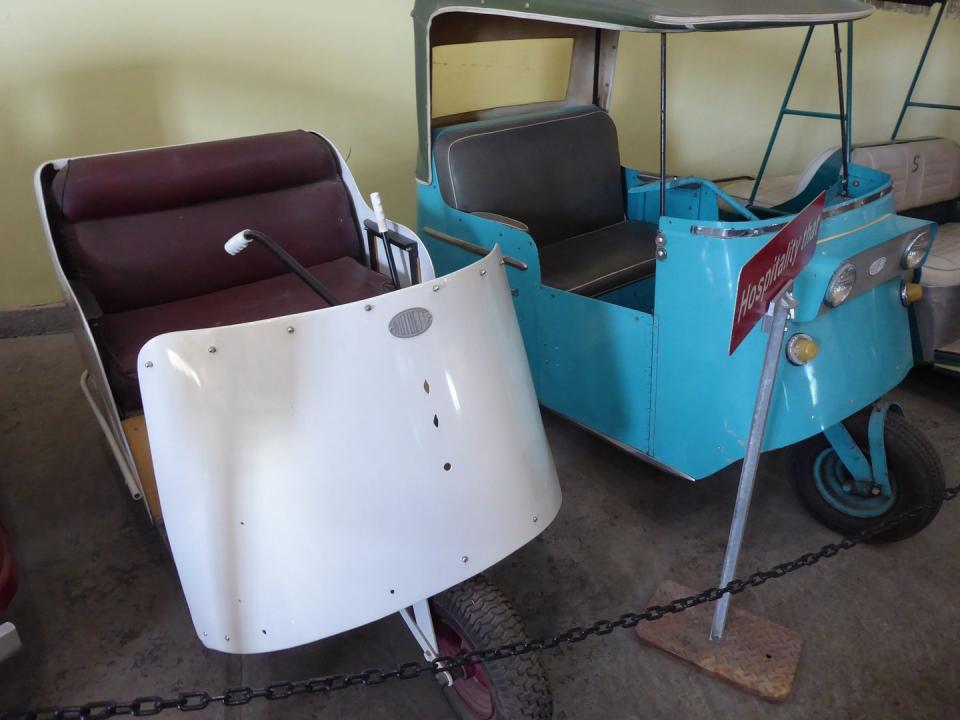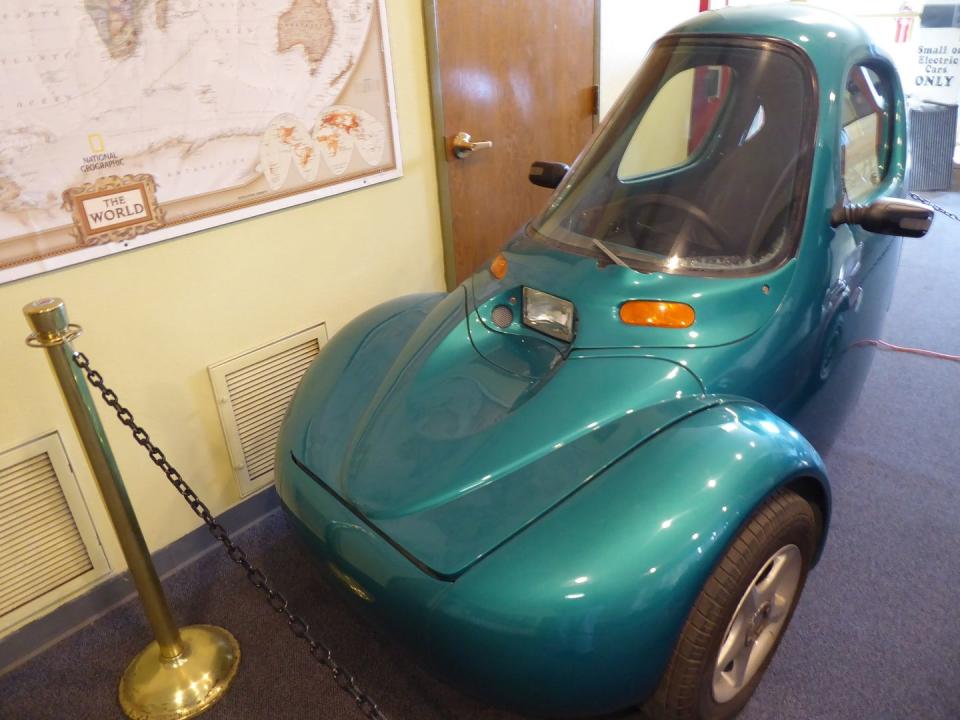Curiosities and Whimsy Abound at This Museum Devoted to Electric Vehicle History

"Hearst Magazines and Yahoo may earn commission or revenue on some items through these links."
Walk into the Historic EV Foundation’s Route 66 Electric Vehicle Museum on Andy Devine Avenue in Kingman, Arizona, and, immediately, you know you’re in good hands. Yes, that really is Willie Nelson’s bright red Rolls-Royce-themed electric golf cart, complete with “Willie” embossed on the seats. And right next to it is pal Waylon Jennings’ similar cart, albeit Mercedes-Benz themed.
Roderick Wilde, a founder of the museum and the foundation, says he’s amassed “the world’s largest collection of historically significant electric vehicles,” and there’s no reason to doubt him—because of that “historically significant” caveat. The history of EVs is not all that well documented (though I tried to do it in my book, Forward Drive), so it’s a treat to see all these marques previously glimpsed only in grainy black-and-white photos. Wilde, who has a base in Croatia, is also a fabricator, building among others the “Maniac Mazda,” a converted 1979 RX-7 that could reach 60 mph in 2.3 seconds. “When I hit the pedal, I want it to scare me,” Wilde told the paper in his Washington state hometown. The museum has Wilde’s bright yellow street racer, “Lightning Rod II.”

The museum’s collection isn’t strong on the EV’s first coming, though there is a 1930 Detroit Electric, already an anachronism with delightful curved glass side windows, and the Custer Chair. The latter has nothing to do with the Little Big Horn, but was a kind of motorized tricycle wheelchair developed by Ohio-based aviation pioneer Luzern Custer and manufactured between 1919 and 1933. There was also a gas version that got 75 miles to the gallon and could be driven on the street—by people with a death wish.
The bright turquoise cart-type 1959 Marketeer is from a company with a colorful history. Merle Williams claimed to have invented the “world’s first electric golf cart” in Long Beach, California, during World War II. Williams built his first EV as a runabout for his wife to go to the market during gas rationing, hence the name Marketeer Electric Vehicles. The company later moved to Redlands, California, and started building golf carts and neighborhood EVs. There was also “an electric feed cart for poultrymen.” Westinghouse bought the company in 1965, and it was later owned by powerboat racer Bob “Ironman” Nordskog, who worked on Howard Hughes’ “Spruce Goose” wooden airplane. This video explains more:
The museum has a 1960 Electric Shopper micro car and a 1966 Autoette “Power Car.” The 700-pound Shopper was made by the Electric Car Company of Long Beach, California, founded in 1951. The car was cute as a button, and even sported miniature fins. The company also made light trucks, flatbeds, and even an eight-passenger personnel carrier for amusement parks and other uses. The Autoette Sales and Service Co. was related to the Electric Car Company, with the latter hiring several of the former’s salesmen. The museum’s white Autoette is crude, with a hand tiller.
The Shopper boasted a 1.5-horsepower, 24-volt DC motor, and could reach 18 mph, with range of up to 35 miles. Options were foot controls, a removable fiberglass hardtop and even a windshield and side curtains.
From Britain comes the Peel Trident, a car bizarre enough to grace both the Ripley’s Believe it or Not Museum in Manhattan and the Lane Motor Museum in Nashville. Peel built what was billed as the world’s smallest car, and it was interesting enough to inspire replicars. Early Peels had 50-cc gas engines, but electric versions have been built with disc brakes, a “high-torque DC motor” and 30-mph top speed. There are hardtops and convertibles.
The 1970 Lyman Electric Quad, a sort of motorized rickshaw, was manufactured in Norwalk, Connecticut, as was your correspondent. It boasted two speeds, one that took it to 10 mph and the other to the Shopper’s 18, and 25-mile range. It has skinny bike tires, a high-mounted buggy seat, and looks about as safe as a motorcycle jump across the Grand Canyon.

Even newer was the Corbin Sparrow out of Tallmadge, Ohio. These blobby single-seaters were produced for four years between 1999 and 2003 and sold for $30,000. Range was only 50 miles at most, but 70 mph speeds were possible. Mike Corbin was an electric engineer who served on the USS Ranger during the Vietnam War, and returned home to make motorcycle seats and parts. Corbin’s EVs were inspired by the 1974 oil crisis. He first tried motorcycles, and his Quicksilver electric bike reached 171 mph on the Bonneville Salt Flats.
The Sparrow PTM (Personal Transit Module) was a three-wheeled commuter car with a plastic body, offering a 20-kilowatt motor and one-cent-per-mile operating cost. It required only a motorcycle license to operate. The Achilles heel was the rack of 13 heavy 12-volt lead-acid batteries; had lithium-ion been around then, the company might have been successful. There were frequent breakdowns, because when one battery went out, they all did. You may remember seeing a Sparrow in the Austin Powers film Goldmember (2002). Some 289 were built.
Canada’s Bombardier built neighborhood electric vehicles around the same time. The NEV (at right in the photo) debuted in 1996, and cost $7,000. It had all of 5.3 horsepower, and 30-mile range. It was a grocery getter, useful in gated communities—but not on the public roads.
Taking up a lot of museum space (lengthwise at least) was the one-and-only electric Buckeye Bullet 2.5, a land-speed record car built with Ohio State University and Monaco-based Venturi that attained 307.666 mph in 2009 on the Bonneville Salt Flats—where Corbin also competed.
Also on the floor was an electric Porsche 911 and a Tesla Roadster, both looking almost mundane in this exotic company. The museum is looking for a GM EV1, any early electric made before 1930, and a Mercury Arc Rectifier EV charging station.

The museum, by the way, is downstairs from the Arizona Route 66 Museum, which is big on dioramas (including one of a westbound prairie schooner). There is also a very cool bullet-nose 1950 Studebaker Champion on display to represent the heyday of the cross-country highway in the 1940s and 1950s.
The September 1979 issue of Motor Trend included a roundup of EVs, all from shoestring independent operations, then on the market. “The Electrics are Coming,” it said. Yes, they were, but the mainstream automakers didn’t get involved until decades later. Back then, some homespun EV choices were the Urba Electric (built from a kit), the Lectric Leopard (a battery Renault Le Car), the Electra King Car (a three-wheeler), the Marathon C-300 (a convertible without doors), the Electruck (electric Jeeps via AM General), the Centaur (developed from a Honda 600), and the JMJ Electracar (a converted Dodge Omni). Some used golf cart batteries, and range (often stated optimistically) was about 50 or 60 miles. Any one of these cars would make excellent additions to the Route 66 Electric Vehicle Museum.

Share your thoughts on the weird and wacky world of historic EVs in the comments section below.

 Yahoo Autos
Yahoo Autos 